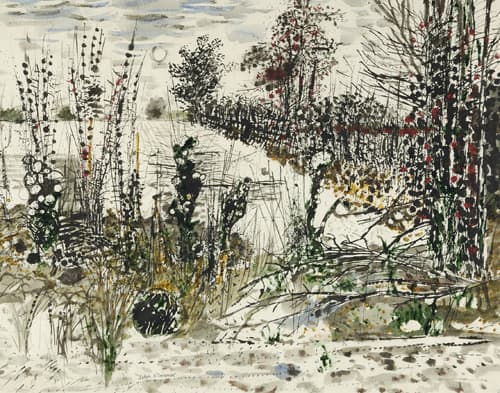
John O’Connor – Lingley’s Field
Biography
John O’Connor busy career began in 1931 when at the age of eighteen he attended the Leicester School of Art. In 1933 he then went on to study at the Royal College of Art for a further four years, studying under John Nash and Eric Ravilious. His decorative approach to wood engraving and an interest in time and space lead for his work to be expressionistic rather than impressionistic; on the whole absent of figures in an attempt to distil the mood of the place.
After his stint in the RAF as part of his war service O’Connor started a family with Jenny Tennant in 1946. The following year he was elected to the Royal Society of Painters, Etchers and Engravers. He then became principle of the Colchester School of Art and was a visiting lecturer to St Martins School of Art after leaving his post at Colchester in 1964, and by 1965 he was an elected senior fellow of the Royal Watercolour Society.
In 1975 he decided to leave Suffolk to live in Scotland, taking advantage of the untamed landscapes and countryside that he so loved. However the teaching bug had not left him and between 1976 and 1982 he was a lecturer at the Glasgow School of Art. In 1990 he then became Honorary Minister of the Society of Wood Engravers.
Exhibitions
1954 Zwemmer Media Arts, London
1955 Royal Academy of Arts, London
1973 The Minories, Colchester
1976 The Minories, Colchester
1977 Graphic Work Retrospective, Glasgow School of Art
1990 Royal Watercolour Society, Bankside, London
Statement
Lingley’s Field demonstrates O’Connor’s dramatic expressionistic qualities, far less decorative than his Field and Hedge in Frost. The bold use of yellow and black, the palette consisting of little else, creates an impact of the viewer. The mass of dark shapes in the foreground some kind of plant; however O’Connor has made little attempt to be representational in any way. This sense of speed and impatience charges the atmosphere with a sense of drama, which is absent from his, more delicate, decorative works. Yet, one may recognise the confident use of line and shape, which is apparent in both his engraving and illustrations. It was important to O’Connor that his work remain timeless in both subject matter and material, thus his lack of interest in figures dehumanises it.
Bibliography
- JONE, Sally, John O’Connor at the Goldmark Gallery, Goldmark Gallery, Uppingham, Rutland, UK, 1993
- John O’Connor Information file, National Art Library
Harriet Pratt




